I listen for the sound of my patient’s beating heart over the sound of my own. Our emergency department (ED) is a carousel today; the flow of patients seems endless. It’s “sink or swim” on days like this, and the fast-paced environment has made me an efficient nurse. I live for the insanity, drama and humanity of our ED. Our home.
Okay, focus on this assessment. Chest pain for two hours, 6 out of 10 pain, feels like pressure in the middle of the chest, a little bit of nausea, no shortness of breath, no palpitations. Obtain vitals, record an EKG, place a cardiac monitor, perform a focused assessment, place an IV, obtain labs and a chest x-ray. Time to see the next patient. Abdominal pain, 4 out of 10 in severity, sharp, localized to the right lower quadrant with nausea and vomiting. Vitals, focused assessment, IV, labs, ultrasound. Next patient.
This day isn’t just another workday, though. Today, I was accepted into medical school, yet no one even knows I applied. I walk the halls of the ED as if everything is normal, but I know my life will change in a few short months. At this thought, my breath quickens. I shake it off and clear my head to get back to work. Shortness of breath for one week, productive cough, inhaler isn’t helping. Vitals, EKG, cardiac monitor, focused assessment. Next patient.
I decided to apply to medical school in my third year of nursing school. I had just returned home from an OB/GYN rotation, when I sat next to my best friend and announced, “I’ve been considering applying to med school.” She responded with a hint of surprise, “That sounds interesting … but I like it.” And that was that. I’ve always been a planner, in constant search for my next great challenge. I realized that becoming a physician would give me the autonomy and the opportunity for leadership I was seeking.
My journey to medical school began typically. I started prerequisite courses in biology and chemistry, began research in clinical health psychology, and volunteered regularly. Unfortunately, I felt alone in this journey. None of my coworkers in the ED were switching careers so soon out of nursing school, and most of my new classes were filled with younger students, fresh out of high school. Nevertheless, I pushed forward, graduated with my BSN, and started practicing as a registered nurse. I eventually found other “non-traditional” pre-medical post-baccalaureate students like myself and leaned on them for support as I navigated a demanding schedule of school during the day and ED shifts at night. Persistence and passion guided me on my road to medical school. Love of my job, lifelong learning, and my patients gave me the motivation to push forward.
I’m not the first nurse to pursue a medical degree, and I won’t be the last. People like me — those who had a career before medical school — get lumped together in a group called “non-traditional students.” Our demographic consists of teachers, technicians, artists, researchers and so much more. “Non-traditionals” are usually older, with life experience to fall back on, and have chosen medical school as a second career. Our medical training journey is less direct, and many of us begin this journey feeling alone. Some have been out of school for years and notice that our studying skills may have atrophied. Yet, while our “non-traditional” past makes us different, our unique perspective and skills will certainly apply to our future careers in ways we cannot predict. Our experiences prepared us to become compassionate, critical-thinking, decisive physicians.
Before applying, I had decided that I wouldn’t tell anyone until officially receiving an acceptance. When the letter from the Philadelphia College of Osteopathic Medicine arrived that afternoon, those years of hard work were validated. CPR in progress, ETA five minutes. Better go set up room one. Code cart, O2, suction, intubation kit, glidescope, IV supplies, Lifepak. I can’t forget my most valued assets: respiratory therapist, physician, two nurses, and a technician. Next patient.
I don’t want to think about leaving my job yet. I have grown immensely in the ED, both as a person and as a nurse. My coworkers have taken me under their wings, saved me when I was drowning, taught me the technical aspects of critical care and helped me learn from my mistakes. How can I leave the place I call home? EMS arrived in the bay. Patient found at home unresponsive, down approximately 30 minutes, significant cardiac history. Compressions, epinephrine, intubate, resuscitate. Spontaneous circulation returned. Next patient. I’ll tell my coworkers another day. For now, I want to savor this feeling of strength and confidence that comes as I navigate the carousel.
I choose to get back on this carousel every day, and it will continue to turn without me while I’m gone. This environment has become a part of me; I know that when I return to the ED as a medical student, I’ll be able to hop right back on the ride. This column is for the non-traditionals, like me. We graduated with a goal, worked with a purpose and returned to school with a dream. I left health care for more health care; I switched stethoscopes on my first day of medical school.
Image credit: Custom drawing by Megan Pattoli for this column.
After working in the emergency room as a registered nurse for three years, Coco made the transition into medical school at Philadelphia College of Osteopathic Medicine. The column Switching Stethoscopes describes a medical student’s journey from nurse to doctor, while reflecting on the “non-traditional” path some students take to become a physician.


